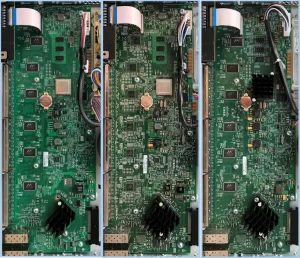In today’s hyperconnected world, Cisco products are synonymous with reliability, security, and cutting-edge networking solutions. However, as demand for these devices grows, so does the risk of counterfeit gear flooding the market. Fake routers, switches, or firewalls not only jeopardize network performance but also expose businesses to security vulnerabilities and legal risks. For IT managers, procurement teams, and even casual buyers, distinguishing genuine Cisco products from counterfeits is critical. This article equips you with actionable strategies to verify authenticity, avoid scams, and ensure you’re investing in trusted technology.

(A side-by-side comparison of a genuine Cisco Catalyst switch versus a counterfeit model, highlighting differences in branding, packaging, and port labeling. Caption: “Spot the difference: Subtle inconsistencies in design and packaging often reveal counterfeit devices.”)
1. Purchase from Authorized Resellers Only
The first line of defense against counterfeit Cisco products is buying through verified channels. Cisco maintains a strict network of authorized partners globally, listed on their official website. Unauthorized sellers, especially those offering prices significantly below market value, are red flags. For example, if a “Cisco ASA Firewall” is listed for 800–$1,200 price range, proceed with caution.
Cisco also offers a Partner Locator Tool on their website, allowing users to search for certified distributors. If you’re unsure about a seller’s legitimacy, contact Cisco’s customer support directly to verify their accreditation.
2. Check Packaging and Serial Numbers
Genuine Cisco products come with meticulously designed packaging. Look for:
- Holographic Seals: Most Cisco devices include holographic stickers or seals that are difficult to replicate.
- Barcode Consistency: Scan the barcode with a Cisco-approved app (e.g., Cisco Trade-In Program) to confirm authenticity.
- Serial Number Verification: Every Cisco product has a unique serial number located on the packaging and the device itself. Visit Cisco’s Software Center or use the Cisco Device Registration Portal to validate it.
Counterfeiters often print serial numbers haphazardly or reuse them across multiple units. In one case, a reseller sold “Cisco Nexus switches” with identical serial numbers—only to have customers discover they were non-functional upon activation.
3. Inspect Hardware and Build Quality
Counterfeit devices often cut corners on materials and components. Genuine Cisco hardware uses premium-grade metals and heat-resistant plastics. Run your fingers along the edges: Authentic routers and switches feel sturdy, while fakes may feel lightweight or plasticky.
Examine ports and interfaces closely. Cisco’s proprietary designs, like the modular ports on Catalyst switches, are precision-engineered. Counterfeit models might use generic connectors or misaligned ports. For instance, a fake Cisco 2960-X series switch might have unevenly spaced Ethernet ports compared to the original.
4. Software and Licensing Verification
Even if a device looks real, its software can expose its true identity. Genuine Cisco products require valid licenses to activate features. Here’s how to check:
- IOS/Cisco IOS XE Version: Boot up the device and log into the command-line interface (CLI). Enter
show versionto check the operating system version. Compare it with Cisco’s official release notes for inconsistencies. - License Registration: Legitimate licenses are tied to the device’s serial number. Log into Cisco’s Smart Net Total Care portal to verify active licenses.
- Firmware Updates: Counterfeit devices often lack access to official firmware updates. Attempting to update a fake device may trigger error messages or fail entirely.
A network administrator shared a cautionary tale: After purchasing “Cisco Aironet access points” from a third-party vendor, his team discovered they couldn’t install licensed IOS versions, rendering them virtually useless for enterprise deployment.
5. Watch for Subtle Design Flaws
Counterfeiters often replicate Cisco’s branding but miss minor design details. Use these clues:
- Logo Alignment: Genuine Cisco logos are laser-etched or embossed with precise spacing. Counterfeit labels may appear pixelated or crooked.
- Model Number Consistency: Check that the model number on the device matches the packaging. For example, a “Cisco C3560CX” switch should have the exact same model number on both the chassis and the box.
- Color Schemes: Cisco uses specific color palettes (e.g., black and silver for enterprise switches). Mismatched hues or cheap-looking finishes are warning signs.
6. Leverage Community and Expertise
The networking community is a valuable resource for spotting counterfeits. Engage with forums like Spiceworks or Reddit’s r/networking to share photos of suspicious devices. Seasoned professionals can often spot fakes based on obscure design quirks.
For high-stakes purchases, consider hiring a third-party inspector. Companies like TÜV Rheinland specialize in verifying hardware authenticity, providing certificates of genuineness for a fee.
7. Avoid “Too Good to Be True” Deals
If an offer seems unrealistic, it probably is. Legitimate Cisco partners rarely discount products by more than 10–15%, even during sales. Scammers often lure buyers with “liquidation auctions” or “overstock deals,” then ship counterfeit goods. Always ask for detailed invoices and warranty documentation.
In an era where counterfeit technology threatens both budgets and cybersecurity, vigilance is non-negotiable. By sticking to authorized sellers, scrutinizing physical and digital details, and leveraging community insights, you can protect your organization from fake Cisco products. Remember: Investing in authenticity isn’t just about cost—it’s about safeguarding your network’s integrity and performance.

Leave a comment